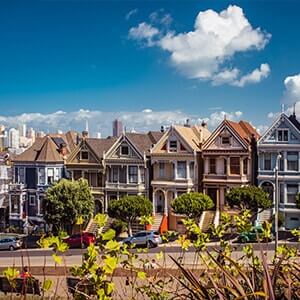Moving to San Francisco
San Francisco is one of the most desirable places to live in Northern California. Many people relocate to the area who work in tech, as it is part of the Silicon Valley – home to many successful tech businesses and startups. But this isn’t the only reason people are drawn to San Francisco. The city offers beautiful views, plenty of recreational activities, beautiful culture and food and so much more.
If you’re planning on moving to the US from the UK or elsewhere, for work or any other reason, you’ll want to familiarise yourself with the area beforehand. Read on for our guide to moving to San Francisco.
Orientation
San Francisco sits at the tip of a peninsula in Northern California. It’s dramatic topography and scenic landscapes make it a unique city which attracts millions of tourists every year. The city itself is fairly small, with only around 750,000 residents living there, however the wider metropolitan nine county Bay area is home to just under seven million.
San Francisco sits under Pacific Standard Time (PST), which is equivalent to Greenwich Mean Time (GMT) minus 8 hours, or Eastern Standard Time (EST) minus 3 hours.
San Francisco has a mild climate, with warm winters and cooler summers. The city is unfortunately famed for its fog, which can be particularly prevalent along the coast during the summer months. This fog will often burn off by midday and return in the evening. There are several microclimates within the Bay Area of San Francisco, meaning that weather can vary greatly from location to location. For example, whilst one neighbourhood may be cool and foggy, just 30 minutes away the weather is sunny and warm. When looking at housing options, this would definitely be something to consider.
With its bustling business and commercial centre, world-famous restaurants and historic sights and attractions, San Francisco is considered one of the most enticing places to live on the globe. We’ve put together the ultimate international relocation guide to provide further information on moving to San Francisco, USA.

Public Transport
Whilst San Francisco is only a small city, there are a huge variety of transport options which can seem overwhelming. Here are just some of the ways you can navigate around and in/out of the city:
- Airport – There are 3 international airports in San Francisco, including San Francisco International Airport, Norman Y. Mineta San José International Airport and Oakland International Airport. Security measures in American airports have intensified in the past decade, so allow plenty of time for air travel and be sure to have all correct identification and documents to hand.
- Train – There are two commuter rail transport systems in San Francisco, including Bay Area Rapid Transit (BART) and Cal-Train. BART is a heavy rail overground and underground transportation system, which connects San Jose, San Francisco and Oakland suburban areas. The trans are clean, on time and are safe, although caution should be used at night. Cal-Train is a California commuter rail line in the Santa Clara Valley (Silicon Valley) and the San Francisco Peninsula.
- Ferry and water taxi – An increasing number of commuters use the ferry service run by Golden Gate Transit, which operates from early to late in the evening.
- Bus – Buses in the city are ubiquitous, with over 5000 stops. The system is a mix of conventional buses and electric trolley lines.
Driving in San Francisco
Urban planning in San Francisco assumes that each household has a car, except for downtown where public transport is convenient and quicker. If you plan on living in San Francisco and driving, you must get a California driver’s license within 10 days. Here are some driving conditions for San Francisco which you should be aware of:
- Traffic congestion can prove a problem in San Francisco especially on bridges and smaller streets. Always bear this in mind when planning your route.
- Speed limits are 24 to 40 kph/15 to 25 mph in residential areas and 88 to 105 kph/55 to 65 mph on the freeways; look for speed limit signs.
- Parking can be expensive, and many areas require parking permits.
You should register your vehicle and obtain new plates if you plan on driving in San Francisco. In addition, you will also need a certificate to prove that your vehicle complies with the local emission regulations.
The Expatriate Community
San Francisco is a very culturally and ethnically diverse city, and is home to a wealth of expats. This means that the vast majority of foreign residents find it easy to integrate into their local community, wherever they choose to live.
Particular areas in San Francisco are favoured by certain nationalities, for example Chinatown is primarily Chinese and Mission Street is primarily Latino. These communities are typically populated by those who have immigrated to the states permanently, as opposed to people who are living there on a business arrangement.

Understanding the people of San Francisco
The city of San Francisco boasts multiculturalism, with various ethnicities comprising over half of the population. The people in San Francisco are generally civic and open minded.
After WWII, returning gay soldiers found a safe haven in San Francisco, and the LGBTQ+ community there has grown into one that is widely respected.
San Franciscans like to think of themselves as more cultured than their cousins in Los Angeles and their city as more beautiful.
Moving to a new city can be a difficult and challenging prospect, so have a look at some online expat forums such as InterNations to connect with the locals and other expats alike.
Housing in San Francisco
San Francisco has an urban high population density, which means that there is no room for additional construction. The housing market is therefore competitive in all categories, with properties selling almost immediately.
It will take time to navigate the best accommodation property to live in, so do your research on the local neighbourhoods and look at prices. Selecting a good quality, talented estate agent will make a considerable difference to your search.
If you’re searching for short-term housing in San Francisco, there are a number of corporate housing options in various municipalities in the city. The minimum stay is usually one month here. Some hotels in San Francisco can also provide short-term housing.

Schooling in San Francisco
There are a wide range of schooling options available to parents looking to send their children to an educational facility in San Francisco. Both the quality and costs of schools can vary greatly depending on the neighbourhood, type of school and needs of your child, so it’s always recommended to speak to the principal and ask for a tour of the school beforehand.
Schooling System
San Francisco’s Unified School District is the eighth largest in California, educating over 55,000 students every year. Students are assigned to a public school based on their proximity to the school. Parents who can afford private education fees tend to send their children to private schools.
If you wish to enrol your child into a public school, pre-registration begins on November 1st every year. If your moving schedule does not allow for this, we would advise contacting your local school office when you know which town you plan on moving to.
International Schools
There are various international schools in San Francisco, which provide education to children from preschool to high school years. For expats, international schools are usually the first choice. When selecting the best international school for your child, there are a number of different factors to consider. The process can be difficult, so we’ve put together 3 of the top performing international schools in San Francisco:
- The Quarry Lane School
- Shu Ren International School
- Lycée Francais de San Francisco
Preschools
If you have a younger member of the family you will need to consider your pre-schooling options. A place for your child to grow and develop, selecting the right school is important. There are many preschools in the San Francisco area, including a selection of Montessori nursery schools.
Moving to San Francisco Checklist
Our moving to San Francisco checklist highlights everything you need to think about before making the move. This is particularly important if you are planning on moving from a different country. Make sure you review our checklist below before starting your move;
- Visa Application – if you are moving to San Francisco from outside of the USA then you will need to secure a work visa, unless you have a green card. Make sure you are aware of all the terms of your visa or apply here if you haven’t already.
- Check Healthcare – many employers offer healthcare as part of their package but check this out as the US doesn’t have public healthcare unlike European nations. You will need to sort your own healthcare if not.
- International Removals – get in touch with a qualified and experienced international removal agency to help with the move. We have experience moving people to San Francisco and can ensure you have everything you need for your international move.
- Review Neighbourhoods – with such a large city there are a lot of diverse neighbourhoods you should check out before moving. SoMa, Mid-Market and Nob Hill are some of the nicer regions in the city.
- Sort Utilities – it is important that you sort out gas and electric before moving into your property as this will avoid lengthy waits on arrival and expensive bills. Some of the largest providers include Pacific Gas and Aegion.
Do you have any further questions about moving to San Francisco or wish to get a quote? Make sure to get in touch with a member of the team to get a free quote using our online form system.
Interested in information on another country? Take a look at our other International Relocation guides.
Great customer Experiences start here
Very pleasent and helpful. Nothing too much trouble.
Mr M H moved from London, UK to Toronto, Canada
Very helpful and patient even when things got packed that we had to get out again!
Mr M E moved from Enfield, UK to Dorset, UK
Thanks to Graham, Nick and the entire crew!
Mr C D M moved from UK to Singapore
Friendly and helpful crew.
Ms T W moved from USA to Cambridgeshire, UK
